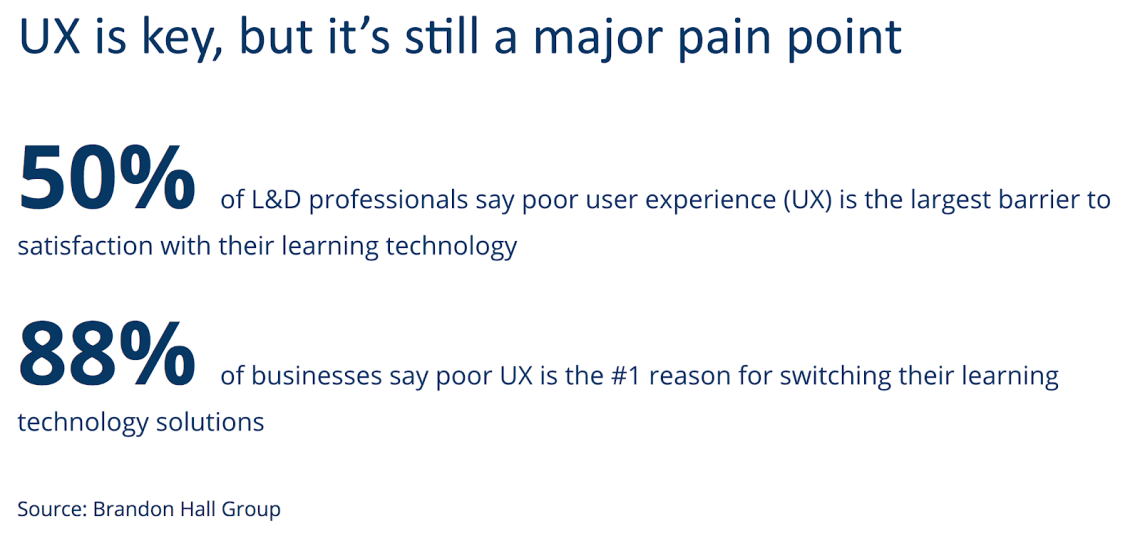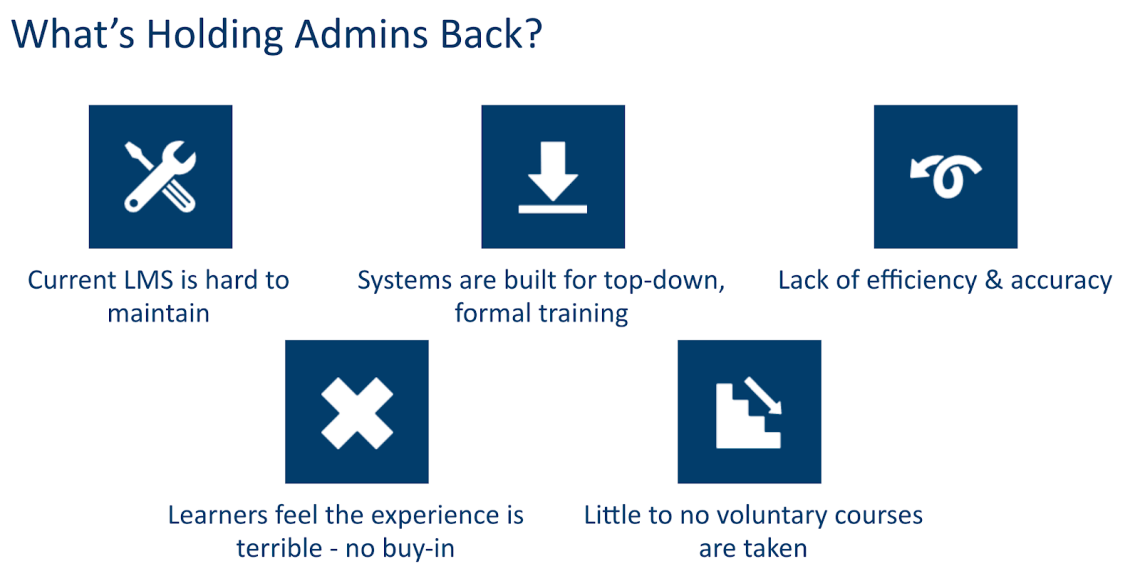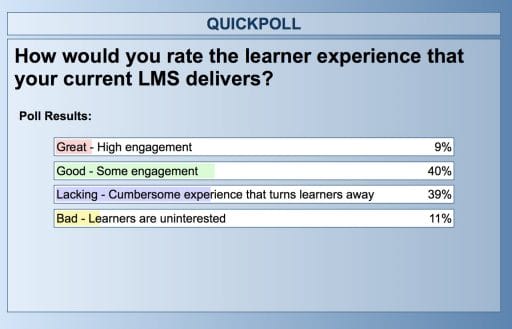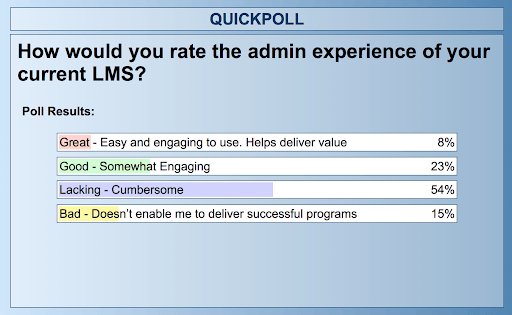 Beyond content, beyond strategy, beyond processes, and beyond technology, the effectiveness of any learning program is ultimately only as good as the learner experience.
Beyond content, beyond strategy, beyond processes, and beyond technology, the effectiveness of any learning program is ultimately only as good as the learner experience.
As you evaluate your existing learning management system (LMS) or scout out a new LMS, you probably have many checkboxes on your criteria list, and one of those should be the learner experience.
Even if learners are provided best-in-class tools and learning programs, if the
actual learner experience does not facilitate a smooth, tailored learning journey, then the ship has sunk before it has even left the harbor.
- What Do We Mean By Learner Experience?
- Today’s Learners Expect Engaging Experiences
- Where Have Learning Systems Failed?
- The 4 Elements of a Great Learner Experience
What Do We Mean By Learner Experience?
In software, we often talk about the user interface (UI) and user experience (UX), but the learner experience encompasses all that and more.
It covers the entire learner experience, from e-learning (online, software-driven), to social and
experiential learning, to traditional, classroom-based learning.
In e-learning, in particular, learner experience carries special weight. It paints a picture of an LMS’s overall capacity to truly engage a learner in their learning journey to help them improve both how they do their job and their contribution to the enterprise at large.
Experience is an emotional flow. Simply put, when we enjoy a positive experience, we are likely to come back for more. This doesn’t mean that companies should stop concentrating on high-quality products. Rather, they should start paying more attention to combining high-quality products with equally high-quality experiences.
Related: Understanding the 3 Aspects of Learner Engagement
Today’s Learners Expect Engaging Experiences
The modern learner:
- Wants to find answers quickly.
- Expects on-demand, personalized experiences.
- Wants a single source of truth.
- Prefers self-paced learning – what they want, when they need it.
- Needs it all to be digestible – informal, social, mobile.
But delivering on these expectations has proven difficult for some L&D professionals as they struggle with lackluster learning experiences.

Where Have Learning Systems Failed?
So, we’ve talked about what learners want or have come to expect, but what is holding admins back from delivering these things?
Some things we’ve heard from customers when talking about their past frustrations are that they didn’t have the technical knowledge required to set up complicated platforms. When trying to create a custom, intuitive experience for their learners, they were expected to basically act as a software developer.
I have also heard that their previous LMS was extremely difficult to maintain. It wasn’t designed to do what they wanted it to do, so they were constantly having to come up with workarounds or solutions to problems.
A lot of times systems are built to support a top-down, formal learning approach, and there’s no way to accommodate social or experiential learning.
One of the biggest obstacles with existing platforms is that the entire experience often depends on the LMS admin: platform configuration, content creation, content recommendations/assignment, manual reporting, the list goes on. The problem is that most of the time, this isn’t their only job.
Admins put all this time and energy into the LMS and still aren’t seeing the buy-in or engagement from their learners due to the poor UX we mentioned earlier.

There are two sides to delivering an engaging learner experience – the experience for the learner and the experience for the LMS admin. In a recent webinar with Brandon Hall Group, we asked the audience how they would rate both the learner experience and the admin experience for their current LMS. It was about a 50/50 split in rating the learner side as either good/great or bad/lacking. But when it came to the admin experience, almost 70% said it was either lacking or a bad experience.


Related: Docebo 7.8 brings personalized learning full circle
The 4 Elements of a Great Learner Experience
There is no one-size-fits-all approach to an e-learning learner experience. Learners learn at their own pace, by their own means, and across different modalities of learning.
However, there are broad factors that can help us figure out what makes a great learner
experience.
1. It’s Easy to Use
If an LMS is cumbersome, complicated or otherwise challenging for its end users, then it shouldn’t be implemented in the first place.
We need LMSs that are in tune with the general conventions people are used to. This comes back to delivering what modern learners expect. There’s no need to reinvent the wheel.
What we know works for platforms like YouTube, Netflix etc. should be reflected in the LMS in order to minimize any friction in achieving learning outcomes.
2. There’s Minimal-to-No Training Involved
This speaks to the previous point, but just as an LMS should be easy to use, it should also have minimal-to-no training involved. Once they log into the system, they should naturally see where their eyes and cursors need to go to fulfill their immediate training objectives. If someone logs into an LMS and has to ask questions off the bat, then we have problems.
3. It’s Actually Fun to Use
A step beyond being easy to use is actually being fun to use. A system that is appealing, familiar, and engaging for users will ultimately help them learn more effectively and let L&D professionals rest easier knowing that their learners are acquiring knowledge at a good pace.
4. It Leverages Known Conventions
We’ve talked about how an LMS doesn’t have to reinvent the wheel of learning. So too, e-learning systems do not have to reinvent how users acquire new knowledge and skills.
Learners are learning online every day – how to make recipes, how to make shelves, how to learn languages – they do this all with known and seamless learning conventions.
Understand how they learn effectively in their day-to-day lives and use the essentials of those approaches to truly engage learners.
Related: How to Scale Your Learning Efforts While Improving the Learner Experience
It All Starts With The Experience
An L&D program is only as effective as a user’s capacity to actually use the LMS that supports that program – and we’re talking both learners and admins. These users are the most critical aspect of success in any L&D program. They need to be provided with an experience that is effortless, engaging, seamless, quick, and convenient.
Any element of learner experience that holds people back from completing course material, and learning effectively ultimately cripples the entire enterprise of L&D in the first place.
Want to learn more about delivering a modern learner experience? Watch our webinar with Brandon Hall Group, The Modern Learning Experience – Is Your LMS Holding You Back?
